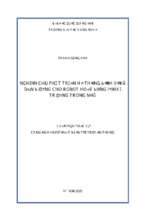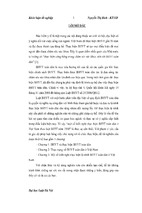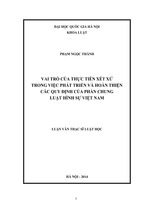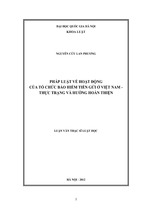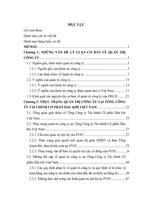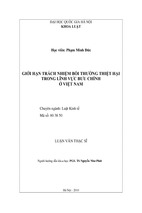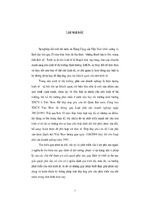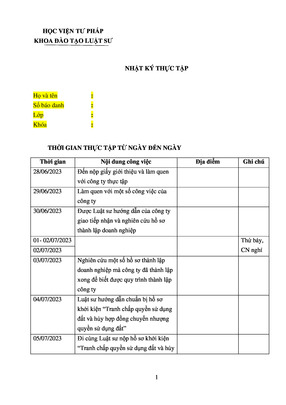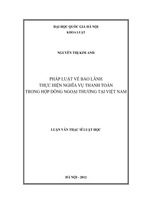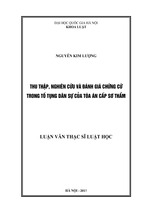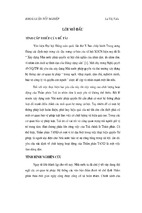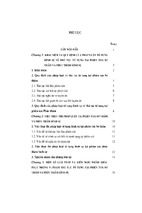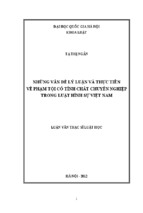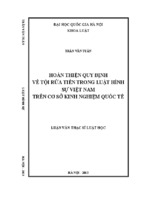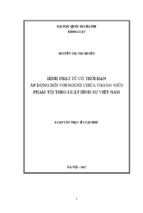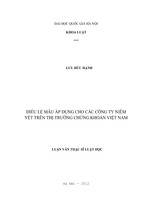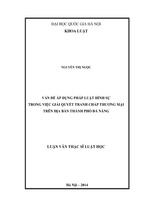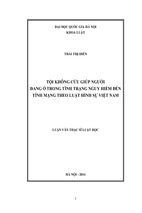HO CHI MINH CITY UNIVERSITY OF LAW
FACULTY OF INTERNATIONAL LAW
-----------***-----------
NGUYEN THI KIM Y
STUDENT ID: 1853801014228
SHIP ARREST TO SECURE
MARITIME CLAIMS UNDER
INTERNATIONAL CONVENTIONS
AND VIETNAMESES LAW
BACHELOR THESIS
School year: 2018 – 2022
Supervisor:
LL.M Vo Hung Dat
Ho Chi Minh City – Year 2022
HO CHI MINH CITY UNIVERSITY OF LAW
FACULTY OF INTERNATIONAL LAW
-----------***------------
NGUYEN THI KIM Y
STUDENT ID: 1853801014228
SHIP ARREST TO SECURE
MARITIME CLAIMS UNDER
INTERNATIONAL CONVENTIONS
AND VIETNAMESE LAW
BACHELOR THESIS
School year: 2018 - 2022
Supervisor:
LLM. Vo Hung Dat
Ho Chi Minh City – Year: 2022
DECLARATION
I declare that this thesis is the result of my research, which is implemented
under the supervision of LL.M Vo Hung Dat, ensures honesty, and complies with
rules and regarding quotation, the note of references. Therefore, I hereby take full
responsibility for this declaration.
I am also deeply indebted to my family, my friends, my supervisor and Ho
Chi Minh University of Law for all their assistance and support for me throughout
the production of this research.
TABLE OF CONTENTS
LIST OF ABBREVIATIONS ................................................................................... 6
INTRODUCTION ..................................................................................................... 1
CHAPTER I. GENERAL THEORY ....................................................................... 6
1.1.
Definitions .................................................................................................. 6
1.1.1. Definition of ship arrest ........................................................................... 6
1.1.2. Characteristics of ship arrest to secure martime claims .......................... 7
1.1.3. “Detention of ship” and “Seizure of ship” .............................................. 9
1.2.
Maritime liens and maritime claims ...................................................... 10
1.3.
Action in rem and action in personam .................................................. 12
1.4.
Development of regulations on ship arrest ........................................... 16
1.4.1. International conventions ...................................................................... 16
1.4.2. In Vietnam ............................................................................................. 19
Conclusion of Chapter I..................................................................................... 21
CHAPTER II. REGULATIONS ON SHIP ARREST TO SECURE MARITIME
CLAIMS .................................................................................................................. 22
2.1.
The notion of “Ship” ............................................................................... 22
2.2.
Classification of Maritime Claims ......................................................... 23
2.2.1. New maritime claims............................................................................. 23
2.2.2. Other maritime claims ........................................................................... 25
2.3.
Conditions of Ship Arrest ....................................................................... 29
2.3.1. Arrest of ship direclty raising maritime claims ..................................... 29
2.3.2. Arrest of Sister Ship .............................................................................. 35
2.4.
Procedure of Ship Arrest ........................................................................ 37
2.4.1. Jurisdiction of Ship Arrest ..................................................................... 37
2.4.2. Procedure of Ship Arrest ....................................................................... 38
2.4.3. Release from arrest.............................................................................. 43
2.5.
Right of Rearrest and Multiple Arrest .................................................. 46
2.6.
Recommendations on regulations on ship arrest to secure maritime
claims in Vietnam ............................................................................................... 48
2.6.1. Examining Vietnamese regulations on ship arrest ................................ 48
2.6.2. Accession to conventions on ship arrest ................................................ 49
Conclusion of Chapter II ................................................................................... 52
CONCLUSION ....................................................................................................... 53
LIST OF ABBREVIATIONS
BRUSSELS CONVENTION 1952
International Convention Relating To The
Arrest Of Sea – Going Ships 1952
MLM 1993
International Convention On Maritime
Liens And Mortgages 1993
GENEVA CONVENTION 1999
International Convention On Arrest Of
Ships 1999
ORDINANCE 2008
Ordinance No.05/2008/Pl-Ubtvqh12 On
Procedures For The Arrest Of Seagoing
Ships
DECREE 57
Decree No.57/2010/Nđ-Cp On Detailing
And Guiding The Implementation Of The
Ordinance On Procedures For The Arrest
Of Seagoing Ships
MC 2015
Maritime Code 2015
CPC 2015
Civil Procedure Code 2015
INTRODUCTION
1.
The neccessity of research
With the strategy of development of marine economy, shipping in Vietnam
is increasingly expanding1. This leads to exciting maritime activities in our country’s
seaports as well as the expansion of Vietnamese ships to the world. In addition to the
positive aspects, recently, the number of Vietnamese ships detained at abroad
seaports as well as foreign ships detained at Vietnamese seaports have increased
rapidly. The arrest of ships can result from many reasons, one of the main reasons
being a maritime trade dispute. And it is sure that the value of maritime trade disputes
is significant value. Currently, arrest of ships is regulated in Chapter VI of MC 2015,
the Ordinance 2008 and relevant documents. In addition, the arrest of ships is also
regulated in international conventions such as Brussels Convention 1952 and Geneva
Convention 1999. This topic will focus on studying issues related to the procedures
for arresting ships according to the provisions of both international conventions, at
the same time, combine with researching on Vietnamese regulations governing on
ship arrest to secure maritime claims. Moreover, this topic also guides many practices
in arrest of ships, thereby bringing out inadequacies in current legal regulations. From
this point, the topic will compare and find solutions to improve the law of Vietnam
to contribute to protect domestic maritime enterprises and promote international
shipping integration.
Key words: ship arrest, maritime claims, Brussels Convention 1952, Geneva
Convention 1999, Maritime Code 2015, the Ordinance 2008.
2.
The purpose of research
The first goal of this research is to analyze and make comparisons between
Brussels Convention 1952 and Geneva Convention 1999. Besides, the assessment of
1
Vinamarine, “Hàng hóa càng biển Quảng Ninh tăng hai con số”, https://www.vinamarine.gov.vn/vi/tin-
tuc/hang-hoa-qua-cang-bien-quang-ninh-nam-2020-tang-hai-con-so (access on 29/3/2022).
1
Vietnamese law on ship arrest is carried out based on the previous comparison,
national legal regulations, and judicial practice to explore advances as well as
shortcomings of existing Vietnamese legal regulations. Afterwards, the research
venturous not only offer solutions to contribute to legal grounds on ship arrest in Viet
Nam in line with standards of international conventions but also makes comments on
accession in international conventions on ship arrest.
The second goal is to present the procedure of ship arrest in Vietnam. The
thesis is considered as an important source for subjects interested in maritime field as
well as relevant issues of ship arrest to consult when conducting the ship arrest
procedure or researching relevant legal issues.
3.
The object and limitation of research
In the term of the main object of the researching, the thesis focuses on
regulations on ship arrest under Brussels Convention 1952, Geneva Convention 1999
and Vietnamese legal documents. Besides, the thesis also researches practical issues
of ship arrest in some countries to clarify posibility application regulations of ship
arrest in fact.
In the term of the limitation of the researching, the author concentrates on
studying main issues including claims raising the right of ship arrest, conditions of
ship arrest, the procedure of ship arrest and the matter in respect of right of rearrest
and multiple arrest.
4.
The methodology of research
Generally, the thesis is carried out based on the basis method being dialectical
materialism. Besides, the author conducts to combine variety methods during
researching as follows:
In chapter I, the author applies synthetic method to obtain collective
information of general theory to establish the backgound for further analysis in
chapter II. Besides, the author combines analytical method with comparative method
to clarify definitions which easily leads to misunderstand such as arrest and detention,
maritime liens and maritime claims, action in rem and action in personam.
2
Similar to chapter I, chapter II is conducted based on three most common
methods such as systhetic method, analytical method and comparative method. The
purpose of chapter II is to clarify similarities as well as differences among both
conventions and Vietnamese legal system and try to explain reasons leading to those
differences. To achive this goal, systhetic method is used to collect information in
many documents; then, analytical method is applied to analyze collective information;
lastly, the author uses comparative method to explore features of ship arrest in
different legal documents and shortcomings in Vietnamese regulations. On this
ground, the author strongly gives opinion to develop legal frame on ship arrest in Viet
Nam.
5.
The literature review of research
Up to the present time, the issue of arrest of ship has been studied in many
intensively articles in Viet Nam, as follows:
-
Nguyen Thi Kim Quy (2005), “Bắt giữ tàu biển trong hàng hải quốc tế
và vấn đề hoàn thiện pháp luật Việt Nam”, Master Thesis, Hanoi Law Univerity: The
thesis focuses on analyzing regulations on ship arrest specified in Maritime Code
2005 and international conventions. Besides, the thesis examines practice of ship
arrest in Ho Chi Minh in the period from 1994 to 1997.
-
Vo Hung Dat (2018), “Bắt giữ tàu biển nhằm đảm bảo giải quyết khiếu
nại hàng hải theo Công ước Geneva 1999 và pháp luật Việt Nam”, Master Thesis, Ho
Chi Minh University of Law: This research focuses on regulations on ship arrest
(except the issues in respect of wrongful arrest, rearrest and multiple arrests) specified
Geneva Convention 1999 and make a comparison with Vietnam. Meanwhile, the
research finds shortcomings of Vietnamese laws and presents recommendations to
develop the law and accede to the convention on ship arrest.
-
Le Phuong Dung (2015), “Công ước quốc tế năm 1999 về bắt giữ tàu
biển và việc gia nhập của Việt Nam”, Master Thesis, Hanoi Law University: The
thesis researches issues of ship arrest under Geneva Convention 1999 and the
experience of foreign countries as state parties of this convention. Afterwards, the
3
thesis examines Vietnamese regulations on the previous research and develops some
recommendations for Vietnam to accede to Geneva Convention 1999.
Besides, other researches also analyzes ship arrest as follows: Nguyen Tien
Vinh (2015), “Một số vấn đề pháp lý về việc Việt Nam gia nhập Công ước quốc tế
về bắt giữ tàu biển năm 1999”, Science of Procuracy, Hanoi Procuracy University,
Vol 04 (08), page 3 – 8; Phan Thi Ngoc Ha (2010), “Một số vấn đề lý luận và thực
tiễn về bắt giữ tàu biển theo pháp luật Việt Nam và hướng hoàn thiện”, graduate thesis,
Ho Chi Minh University of Law;
In foreign countries, there are many international researches on arrest of ships
to ensure settlement of maritime claims as follows:
-
Stanley Onyebuchi Okoli (2010), “Arrest of Ships: Impact of the Law
on Maritime Claimants”, Master thesis, Lund University: The thesis researches
historical development of admiralty jurisdiction and action in rem in England, the law
of ship in accordance with Brussels Convention 1952 and Geneva Convention 1999
as well as issues in respect of maritime claims, liens and mortgages under the 1926
Liens and Morgages Convention and the 1993 Liens and Morgages Convention.
-
Nadiya Isikova (2012), “The Ship Arrest Conventions of 1952 and
1999: international and Ukrainian perspectives”, Dissertations, World Maritime
University: The primary goal of this dissertation is to investigate regulations on ship
arrest through a comparison of both Brussels Convention 1952 and Geneva
Convention 1999. In the meanwhile, the dissertation will examine Ukrainian law by
focusing on national laws as well as judicial practice.
Other studies examine ship arrest in the following ways: Md.Rizwanul Islam
(2007), “The Arrest of Ship Conventions 1952 and 1999: Disappointment for
Maritime Claimants”; Hill Dickinson (2003), “Arrest regimes: Comparing English
law, and the position under the Arrest Convention 1952 and the Arrest Convention
1999”;
6.
The structure of researching
4
This dissertation is divided in two main chapters as following:
Chapter I: General theory
Chapter II: Regulations on ship arrest to secure maritime claims
Besides, the thesis also includes other parts such as: Introduction, conclusion,
bibliography and annexes.
5
CHAPTER I. GENERAL THEORY
1.1.
Definitions
1.1.1.
Definition of ship arrest
Arrest of ships is a prominent feature of admiralty law in common law.2
Especially, in England, there was a development of ancient admiralty law, which
spurred the formation of the basis for arrest of ships in rem which used in most
common countries. Regarding to ship arrest under English law, the Anna H,
Hobhouse L.J presented as follows: “In English law, the arrest of a ship or other
maritime property in an admiralty action in rem involves the detention of the ship by
the Admiralty Marshal subject to the directions of the Admiralty Court in judicial
proceedings to secure a maritime claim.” In England, the arrested ship will be under
the power of the court, at that time, the vessel will legally stop or restricted move or
trade, pending the resolution of the court decision concerning an action in rem.
According to international conventions on admiralty field, especially
Brussels Convention 1952, defined arrest of ship: “Arrest” means the detention of a
ship by judicial process to secure a maritime claim, but does not include the seizure
of a ship in execution or satisfaction of a judgment.3 By the formation of Geneva
Convention 1999, a new modern definition of ship arrest can be seen, as followed:
“Arrest" means any detention or restriction on removal of a ship by order of a Court
to secure a maritime claim, but does not include the seizure of a ship in execution or
satisfaction of a judgment or other enforceable instrument.4 Despite of being still
simple and obvious definition, this difinition is more widely than one in Brussels
Convention 1952, covering detention of a ship and restriction on removal of a ship.
2
Cornell
Law
School,
“Admiralty”,
https://www.law.cornell.edu/wex/admiralty#:~:text=Admiralty%20law%20or%20maritime%20law,procedur
al)%20governing%20navigation%20and%20shipping (access on 27/3/2022).
3
Ariticle 1 (3) of Brussels Convention 1952.
4
Ariticle 1 (2) of Geneva Convention 1999.
6
In Viet Nam, MC 2015 defined that “Arrest of ships refers to detention or
restriction on removal of a ship by order of a Court to secure a maritime claim, apply
interim injunctions, enforce civil judgements and perform mutual legal assistance.”5
Both international conventions and Vietnamese law have indicated the arrest of ship
being an act which reflects the particular to restrict its removal. In addition to the
purpose of securing maritime claims, the arrest of ship under Vietnamese law also
aim to apply interim injunctions, enforce civil judgements or perform mutual legal
assistance. In fact, Vietnamese scholars gave their opinions of ship arrest as a judicial
action to obtain security property to settle claims on obligations related to the ship or
itself.6
1.1.2.
Characteristics of ship arrest to secure martime claims
The outstanding feature of ship arrest to secure maritime claims is the
procedure basing on the civil proceeding. It is acknowledged in international treaties
on arrest of ships, specifically Brussels Convention 1952 recognizing ship arrest as
the “judicial process”7. Besides, Geneva Convention 1999 also presents that arrest
of ship is carried out by an order of a Court being a judicial authority.8 Therefore,
there is no doubt that ship arrest to secure maritime claims is the special procedure.
This procedure with its function as a civil remedy serving the requesting person to
arrest the ship to guarantee compensation for damage or a certain commitment made
by the shipowner or the charterer, is separate from the handling and settlement of
disputes related to the ship or disputes between the claimant and the defendant.9 In
theory, it is like a form of interim or pre-trial remedy and a creditor may obtain
5
Article 129 of MC 2015.
Nguyen Tien Vinh, “Các mô hình pháp luật tiêu biểu về bắt giữ tàu biển trên thế giới”, Journal of Vietnam
National University, Hanoi, No.4/2016, p.2.
7
Article 1 (2) of Brussels Convention 1952.
8
Article 1 (2) of Geneva Convention 1999.
9
Vo Hung Dat, Bắt giữ tàu biển nhằm đảm bảo giải quyết khiếu nại hàng hải theo Công ước Geneva 1999 và
pháp luật Việt Nam, Ho Chi Minh University of Law, 2018, p.17.
6
7
security by filing a “caution” against release in practice. 10
11
Accordingly, the
jurisdiction to arrest a ship to secure maritime claims is different from the jurisdiction
to settle disputes related to that claim.12 Another prominent feature of ship arrest to
secure maritime claimss is that it has the potential to lead to forced sale or judicial
sale if a ship is still arrested or is found fault on the merits of the case.13 In accordance
with Brussels Convention 1952 and Geneva Convention 1999 have not detailed
forced sale of ship but having the trend of permitting of State Parties’s dealing.14
According to MC 2015, ship arrest has four different purposes including to
secure a maritime claim, apply interim injunctions, enforce civil judgement, and
perform mutual legal assistance.15 Comparing to international conventions on ship
arrest, Vietnamese law also indicates the limit between filing a lawsuit và ship arrest
to secure maritime claims through regulations on the period of arrest of ships.
Accordingly, during the period of arrest of a ship as a manner of securing a maritime
claim, if the person filing a request for such arrest brings proceedings before a Court
or submit a claim to the arbitration tribunal against any dispute and insists on request
for such arrest, the period of such arrest for the purpose of securing the claim shall
terminate whenever the Court decides whether an interim injunction is applied to
arrest such ship. 16 On the matter of forced sale of ships, Vietnamese government
promugalted the Decree 57 to give instructions which state that forced sale is only
permitted after the court issues its judgement or decision without the auction of the
ship for the purpose of supplementing the state budget because the shipowner
abandoned the ship and the claimant did not file or the application being rejected by
the court. In practice, the judicial sale of arrested seagoing ships shall be carried out
in accordance with the judgments of the competent court. Following that, the judicial
10
The UNCTAD Secretariat, Review of Maritime Transport, UNCTAD, 2011, p.111.
Jackson D.C, Enforcement of Maritime Claims Fourth Edition, London Informa Publishing, 2005, p.230.
12
Article 2 and article 7 of Geneva Convention 1999.
13
Nadiya Isikova, The Ship Arrest Conventions of 1952 and 1999: International and Ukrainian perspectives,
World Maritime University, Malmö, 2012, p.6.
14
Article 2 (4) of Geneva Convention 1999.
15
Article 129 of MC 2015.
16
Article 14 (2) of the Ordinance 2008 and Article 141 (2) of MC 2015.
11
8
sale of the arrested ship will be conducted by a property auction organisation after
having the judgment enforcement decision for the judicial sale of the arrested ship
issued by the enforcement agency. The order and procedures for judicial sales of
arrested seagoing ships is regulated with the law on property auction publicly.
Accordingly, the bidders must pay the entrance fees. Meanwhile, the ship-owner
and/or the captain of the arrested ship shall be liable for maintaining the vessel from
the time of arresg until another decision issued from the competent court. It is notable
that creditors having a marine lien get priority over creditors with a mortgage but a
mortgage takes precedence over other types of claims.17
1.1.3.
“Detention of ship” and “Seizure of ship”
Looking through Geneva Convention 1999 and Brussels Convention 1952,
the definitions of “arrest” always appear to use the word “detention”, but only in the
literal or ordinary sense of the term.18 However, in some cases, detention of ship is a
term that easily leads confusion with the nature of “arrest of ship to secure maritime
claim” despite existing many striking fundamental differences between concepts.
While an arrest which prevents the ship from leaving port under the authority of a
court or of the appropriate judicial authority, the detention of a ship are carried out
under Maritime Labour Convention 2006 by Port State Control19 authorities since
this is not a court supervised process.” 20 The main purpose of Maritime Labour
Convention is to provide State Parties with the right to inspect foreign-flagged ships
17
Chambers
and
Partner,
“Shipping
2022”,
https://practiceguides.chambers.com/practiceguides/comparison/653/8202/13076-13084-13089-1309513108-13110-13117-13119-13124 (access on 18/5/2022).
18
Nadiya Isikova, The Ship Arrest Conventions of 1952 and 1999: International and Ukrainian perspectives,
World Maritime University, Malmö, 2012, p.6.
19
IMO, “Port State Control”, https://www.imo.org/en/OurWork/IIIS/Pages/Port%20State%20Control.aspx
(access on 30/3/2022).
20
SRI,
“Arrest”,
https://seafarersrights.org/seafarers-rights-fact-files/arrest-ofships/#:~:text=An%20arrest%20prevents%20the%20ship,not%20a%20court%20supervised%20process
(access on 30/3/2022).
9
when entering their areas to ensure that it has complied with IMO/ILO standards on
maritime safety and security as well as protect the marine environment.
Under Vietnamese law, there is no definition of detention of ship specified
in law. Basing on circumstances raising detention of ship, it can be understood that a
ship can be temporary detained because of involving in an investigation in a marine
accident under which temporary detention is required to serve investigation purposes;
or not paying in full of all statutory fines; or being charged with commission of any
violation against laws for which a temporary detention is imposed in accordance with
laws.21 Ships, which are detained because of causing incidents in the port or fully
unpaid debts or administrative fines for ships itself and person on such board, are
released immediately after the debts and administrative fines have been paid or
guaranteed in accordance with law.22 In conclusion, the nature of detention of ship
being a preventive measure or measure to ensure the handling of administrative or
criminal violations does not arise from maritime claims like ship arrest to secure
maritime claims. This feature itself distinguishes itself from ship arrest to secure
martime claim as a judicial process according to the above analysis.
On the other hand, the term “seizure” is also easily confused with “arrest”,
but it has a different nature from arrest of ship to secure maritime claim. Seizure can
be understood as a measure applied to foreign ships infringing on state’s territorial
sea, including illegal fishing or smuggler ship…; in the meanwhile, the power of
seizure is usually granted patrol at sea.23
1.2.
Maritime liens and maritime claims
In this topic, the author learns about ship arrest for the purpose of securing
maritime claims. Accordingly, maritime claims are one of the main researching
subjects that need to be clearly defined. However, in maritime law, the term
21
Article 114 of MC 2014.
Article 59 (2) of Regulation on Management of marine activities at sea port and martitime zones of Vietnam
(attached to Decree No.13-CP dated February 25, 1994 of the Government).
23
Dang Quang Phuong, Cơ sở lý luận và thực tiễn của việc hoàn thiện pháp luật về bắt giữ tàu biển tại Việt
Nam, The Supreme Court, Ha Noi, 1999, p.5.
22
10
“maritime liens” exists with properties that are easily confused with maritime claims.
So, it is important of course to distinguish both terms. Maritime lien are fully
specified in International Convention on Maritime Liens and Mortgages 1993. In the
meanwhile, basic ground of maritime claims are regulated in Geneva Convention
1999.
There are two alternative definitions of a maritime lien: First, maritime lien
is a right to a part of the property in the res; Second, maritime lien is a privileged
claim upon a ship, aircraft or other maritime property in respect of services rendered
to, or injury caused by, that property.24 The ship which was personified being able to
causing harm, loss or damage to others or to the property and it must itself repair the
damage. Even it makes little sense to the practical mind, in this situation, the ship has
become the wrongdoer, not its owners. A maritime lien is linked to the property
(including ships as well as cargo or freight on board) at the time the cause of action
arises and remains attached (rather like a leech to human skin), following the property
through ownership changes. Maritime liens are unlikely to be transferrable. When an
agent, for example, pays off unpaid crew payments that occurred before to the arrest,
he is no longer entitled to the maritime lien that crew salaries normally entitle him to,
but rather is only a claimant with a statutory right in rem.25 Maritime liens constitute
one category of maritime claims; notwithstanding, some maritime claims are
maritime liens while others are not.26
In Viet Nam, maritime liens is specified in Article 40.1 MC 2015 as a right
of the maritime claimant under Article 41 hereof which gives this claimant a privilege
to submit a claim for compensation against the owner, charterer and operator of a
ship in the event that there is any maritime claim in connection with that seagoing
vessel. On the other hand, maritime claim refers to a party requesting another party
24
Christopher Hill, Maritime Law Sixth Edition, Informa law from Routledge, 2014, p.121.
Yvonne Baatz, Maritime Law Third Edition, Informa law from Routledge, 2014, p.491.
26
Stanley Onyebuchi Okoli, Arrest of Ships: Impact of the Law on Maritime Claimants, Lund University, 2015,
p.47.
25
11
to secure any obligation that may arise out of marine operations. Under Vietnamese
law, maritime claims giving rise to a maritime lien have a higher priority than
maritime claims secured by ship mortgages and other secured transactions.27 Even if
such seagoing ship has been mortgaged or the ship owner has completed other
secured transactions to ensure other agreed-upon obligations are secured, the
claimant shall have the right to maritime liens to secure maritime claims with the
nature of maritime liens. Maritime lien is claimed against the ship in respect of
maritime claims giving rise to the maritime lien. 28 In the same manner with
international perspective, any change in the owner, charterer, or operator of a ship
has no impact on the maritime lien over that ship regardless of whether the buyer has
been informed the fact the ship raising maritime lien.29
1.3.
Action in rem and action in personam
In the period of formation and development of regulations on arrest of ships,
legislators always try to balance the interests of many parties with opposing interests:
between debtors and creditors, shipowners and charterers, shippers, banks or
financial organizations on insurance… Through the long term development, current
regulations on arrest of ships in the world derives from two basic legal theoretical
models: action in rem and actio in personam.30
Action in personam (claims against ship owners themselves)
In this case, the ship (as the property) belongs to an individual or legal entity
being the respondent of the lawsuit. Similar to any other property, the ship may be
held as security to settle claims against a property obligation of the shipowner. In
order to force the shipowner to be liable for civil liability for claims relating to loss
or damage of the ship, salvages, towage, pilotage, loss of life or health, etc.
27
Article 40 (2) of MC 2015.
Members of The Shiparrested.com Netwwork, Ship Arrest in Practice Eleventh Edition, ShipArrested.com,
2018, p.438.
29
Article 40 (5) of MC 2015.
30
Vo Hung Dat, Bắt giữ tàu biển nhằm đảm bảo giải quyết khiếu nại hàng hải theo Công ước Geneva 1999 và
pháp luật Việt Nam, Ho Chi Minh University of Law, 2018, p.12.
28
12
Action in rem (claims against the ship itself)
Obviously, action in rem is distinct from the action in personam. Here, the
action is against the maritime property including vessel or even cargo or freight, but
not against the owner. The ship (as the property) is the object; concurrently, being the
defendant of the case. According to the English law, the statutory right of action in
rem would prefer as a procedural instrument to flush out the liable shipowner rather
than as an action principally intended at the wrongdoing personified ship.31 Arrest of
ship is considered as a measure of settling maritime claims against obligations
relating to property arising directly from the ship itself or its operations. In this case,
arrest of ship is araised from the request of the creditor, the aggrieved persons aimed
at the ship itself regardless of who own the ship, or in case there is a change of the
shipowner, it does not reflect to the claimant’s request of ship arrest to the court. In
comparison with common law countries considering arrest as a device for the
founding of jurisdiction and consequently for commencing proceedings in rem, arrest
of ship under civil countries is seemed like as security for any claim, whether of
maritime or non-maritime nature. Besides, in the case of wrongful arrest, civil law
countries shall hold liable for damage suffered by the ownership against the arrestor,
whereas in common law countries, the owner could only claim security costs based
on release of the ship by providing adequate security.32
It must be admitted that each model has its own pros and cons. But three
following advantages make actio in rem become popular in the maritime field,
especially in common law countries:
First, the cooperation of the shipowner is not required. In action in rem, a
creditor or claimant may bring a lawsuit directly against the ship without specifying
its owner. If the shipowner shows up and is willing to participate the lawsuit to
31
Tetley W., Maritime Liens and Claims Second Edition, Les Éditions Yvon Blais Inc, Montréal, 1998, p. 977978.
32
Berlingeri F., Berlingieri on Arrest of Ships 5th Edition, Informa Law from Routledge, 2011, p.461.
13
response the creditor’s allegations, arresting the ship is considered a measure of
pressure, forcing the ship owner to join the lawsuit. In case the shipowner abandons
the ship and refuse to participate in the lawsuit, the court’s judgment will resolve the
creditor’s claim and claim against the ship itself.
Second, this procedure creates the jurisdiction of the Court. This procedure
allows to arrest the ship even when the court has not accepted petition yet.
Furthermore, as per this procedure, it is allowed to form the jurisdiction of the court
to settle the claimant’s maritime claim. In other words, in the maritime field, a court
in action in rem will have jurisdiction to settle maritime claims if such court has
jurisdiction to arrest of ship, regardless of factors such as: head office, the place of
the respondent, the place of occuring legal events raising the dispute. This is an
outstanding feature because of high movement of ships.
Third, forming a security property for the lawsuit. This is the key benefit of
action in rem. Especially, this model allows the claimant to own a security property
before the court accepts the case to consider the maritime claim.
Unlike action in rem, the concept that the ship (as the property) being the
defendant in the case is unlikely existent. As usual, the respondent must be individual
or legal entity, and in order to ensure the fulfillment of his/her claims as well as
enforment of a judgment, the court has the power to order the arrest of any property
of the defendant, even a vessel or other property. It also creates the advantage of
action in personam, in particular, in accordance with this model, arrest of ship may
be allowed to settle any claims against the respondent who is the shipowner,
regardless of whether directly related to the ship.
Besides, in contrast to action in rem, action in personam can only be
performed when the court has accepted the claimant’s claim. This means that under
the principles of action in personam, the court has the power of ship arrest only if the
claimant’s jurisdiction has been established. Due to this feature, to avoid its
responsibility, in many cases, the defendant’s ship could have been taken out of the
14
- Xem thêm -


